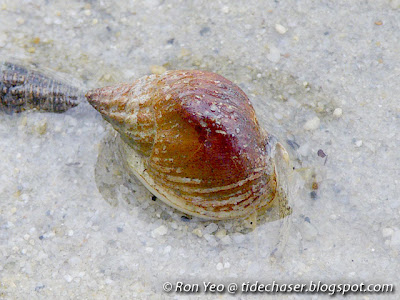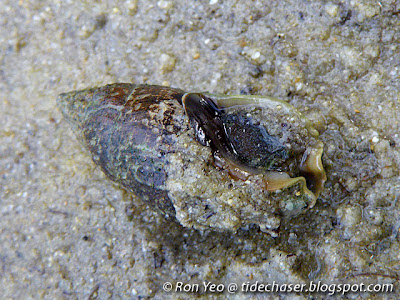The nassariids, also called dog whelk or just whelk locally, are characterised by a tall spire, and a long siphon. They are mostly scavengers, and the long siphons allow them to sniff out dead animals. Some dog whelks have small sea anemones growing on their shells, which get a free ride to food - decaying particles from the carrion the dog whelk is feeding on.
The whelks are possibly my most under-photographed group of snails on our shores, and hence I certainly need to take more photos to improve this entry in future. Here are the whelks that I have seen so far (thanks to Siong Kiat who gave tips on how to identify them!). You may want to take a look at my diagram on the parts of a snail's shell if you are not familiar with the names of the parts, so as to better understand the terms used below.

The Common Dog Whelk (Nassarius livescens), like the other nassariids, has a long siphon. It has a layered, turret-like spire, and numerous fine ridges running down from the spire across the whorls to the siphonal notch. It is about 1.5cm long, and is found mostly on sandy or slightly muddy substrates in the intertidal area. Sometimes, tiny sea anemones may be attached to the shell. Being a scavenger, the whelk will bring the sea anemone with it to the dead animal, and the sea anemone will benefit from the tiny bits and pieces of meat drifting around.

There are numerous tiny spiky teeth on the edge of the operculum.

The Black Dog Whelk (Nassarius pullus) appears more compact and proportionally shorter, with a broad and flattened base. It is about 1cm long, and is usually found on sandy areas.

The lips are thick and broad, extending towards the spire. There is often a blackish stain in the middle of the the white underside.

The Mud Whelk (Nassarius jacksonianus) can usually be found in sandy or muddy areas, often among seagrass or seaweed. It has an obvious spiral band of a lighter colour on its body whorl, dividing the otherwise greyish to brownish stains into two.

The shell is thick with a few teeth on the outer lip.

The Harp Dog Whelk (Nassarius harpularia) is usually found in mangroves. The shell is dark brown to almost black in colour, with a lighter band around its body whorl.

The shell is thick, and the outer lip has a few obvious teeth.

The Mitral Dog Whelk (Nassarius mitralis) is usually found on sandy-mud substrates. It is usually black or dark brown in colour, growing to about 1.5cm long. The whorls of the spire appear more bloated or convex, and the spire is usually shorter than the body whorl. Generally the shell is shaped somewhat like a bishop's mitre with some imagination, and hence the name.

Looking at the underside, it has a corneous opercululm.

The Olive Whelk (Nassarius olivaceus) is much bigger than the previous species, growing to about 4-5cm long. The colour of the shell can be brown, maroon or black. The spire is about the same length as the body whorl, and the whorls do not appear as bloated or convex as the previous species.
References
The whelks are possibly my most under-photographed group of snails on our shores, and hence I certainly need to take more photos to improve this entry in future. Here are the whelks that I have seen so far (thanks to Siong Kiat who gave tips on how to identify them!). You may want to take a look at my diagram on the parts of a snail's shell if you are not familiar with the names of the parts, so as to better understand the terms used below.

The Common Dog Whelk (Nassarius livescens), like the other nassariids, has a long siphon. It has a layered, turret-like spire, and numerous fine ridges running down from the spire across the whorls to the siphonal notch. It is about 1.5cm long, and is found mostly on sandy or slightly muddy substrates in the intertidal area. Sometimes, tiny sea anemones may be attached to the shell. Being a scavenger, the whelk will bring the sea anemone with it to the dead animal, and the sea anemone will benefit from the tiny bits and pieces of meat drifting around.

There are numerous tiny spiky teeth on the edge of the operculum.

The Black Dog Whelk (Nassarius pullus) appears more compact and proportionally shorter, with a broad and flattened base. It is about 1cm long, and is usually found on sandy areas.

The lips are thick and broad, extending towards the spire. There is often a blackish stain in the middle of the the white underside.

The Mud Whelk (Nassarius jacksonianus) can usually be found in sandy or muddy areas, often among seagrass or seaweed. It has an obvious spiral band of a lighter colour on its body whorl, dividing the otherwise greyish to brownish stains into two.

The shell is thick with a few teeth on the outer lip.

The Harp Dog Whelk (Nassarius harpularia) is usually found in mangroves. The shell is dark brown to almost black in colour, with a lighter band around its body whorl.

The shell is thick, and the outer lip has a few obvious teeth.

The Mitral Dog Whelk (Nassarius mitralis) is usually found on sandy-mud substrates. It is usually black or dark brown in colour, growing to about 1.5cm long. The whorls of the spire appear more bloated or convex, and the spire is usually shorter than the body whorl. Generally the shell is shaped somewhat like a bishop's mitre with some imagination, and hence the name.

Looking at the underside, it has a corneous opercululm.

The Olive Whelk (Nassarius olivaceus) is much bigger than the previous species, growing to about 4-5cm long. The colour of the shell can be brown, maroon or black. The spire is about the same length as the body whorl, and the whorls do not appear as bloated or convex as the previous species.
References
- Abbott, R. T., 1991. Seashells of Southeast Asia. Graham Brash, Singapore. 145 pp.
- Ng, P. K. L. & N. Sivasothi (eds.), 1999. A guide to the mangroves of Singapore II: Animal diversity. Singapore Science Centre, 168p.
- Oliver, A. P. H., 2012. Philip's guide to seashells of the world. Philip's, London. 320 pp.
- Tan, K. S. & L. M. Chou, 2000. A guide to common seashells of Singapore. Singapore Science Centre, Singapore. 168 pp.
- Tan, S. K. & H. P. M. Woo, 2010. A preliminary checklist of the molluscs of Singapore. Raffles Museum of Biodiversity Research, National University of Singapore, Singapore. 78 pp. Uploaded 02 June 2010.
- Tan, S. K. & R. K. H. Yeo, 2010. The intertidal molluscs of Pulau Semakau: preliminary results of “Project Semakau”. Nature in Singapore, 3: 287–296.
- World Register of Marine Species. 2012. Retrieved Oct22, 2012, from http://www.marinespecies.org.

No comments:
Post a Comment